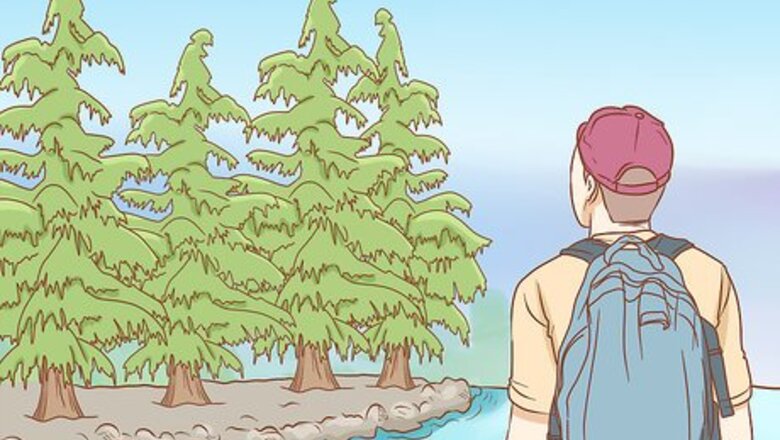
views
Finding Drinking Water
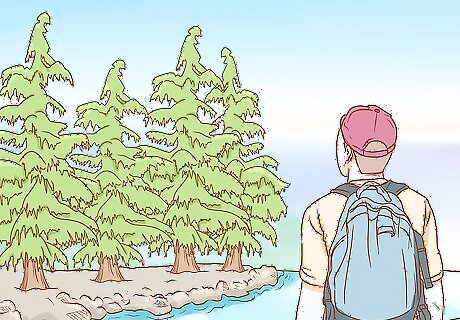
Search for a source of fresh water. The first thing that you'll need in order to survive in the woods is water that you can drink. Look for signs of fresh water nearby like areas of green foliage that indicate water is nearby, low-lying areas where water could be collected, and signs of wildlife like animal tracks. It could mean that a creek, stream, or pond is nearby. While finding water is important for survival, be aware some water sources will not be safe - if possible treat all drinking water before using it. If there are mountains nearby, look for water collected at the foot of the cliffs. The presence of insects like mosquitoes and flies means that water is nearby. Water from heavily oxygenated water (such as from a big waterfall or rapids) typically is safer than that from a slow or still water source. Freshwater springs are typically safer water sources, although these can be contaminated by mineral or bacteria as well. Remember that all untreated water must be considered risky unless treated. Even crystal clear water can harbor diseases and be dangerous if consumed.
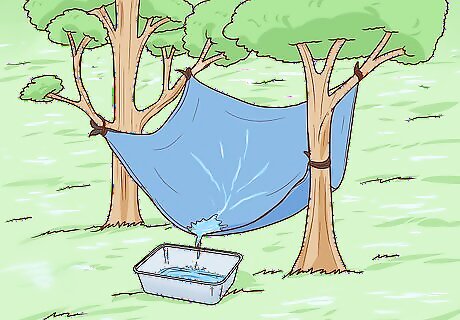
Collect rainwater to drink. Rainwater is one of the easiest and safest ways to hydrate yourself in the woods. If it starts to rain, place any containers that you have out in the rain to collect it. If you have a tarp or a poncho, hang it at least 3–4 feet (0.91–1.22 m) off of the ground by tying the corners to trees, and place a small rock in the center to create a depression that will collect the water. Don't let the water sit in a container or a tarp for too long or it can stagnate and bacteria can contaminate it. If possible, purify any water that you collect.
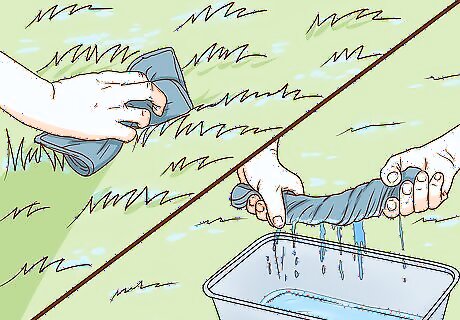
Absorb morning dew with a piece of cloth. Use a rag, cloth, shirt, sock, or any other item of clothing that's made out of absorbent material like cotton to capture morning dew. Find a clearing or a meadow with tall grasses and place the cloth on top of the grass to pick up the dew. Move the cloth around in the grass until it's saturated, then wring out the water, collecting it in a container. You can collect the most dew just before sunrise. Be careful not to collect dew from poisonous plants. Grasses are your safest bet.
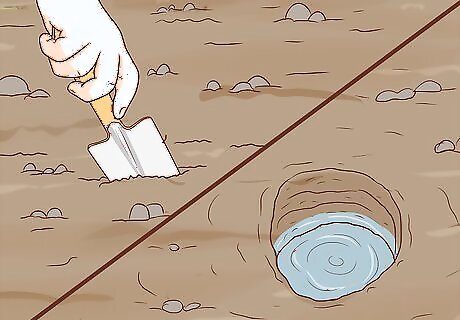
Dig a hole to find fresh water. You may be able to find fresh water simply by digging a hole deep enough to reach the water table or the level at which the ground is saturated with water. Use a shovel or a sturdy stick to dig down until you reach water. Make the hole wide enough so you can easily scoop water from the hole. Wait until the mud settles down at the bottom of the hole and the water clears before you scoop it out.Tip: Look for places like a dried-up stream or an area with lots of green foliage to dig for water.
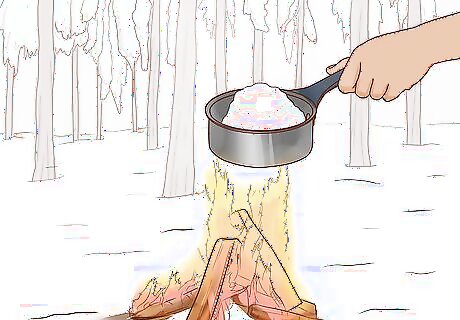
Melt snow or ice if you can find some. If you find ice or snow on the ground in the woods, collect it so you can melt it down for fresh drinking water. You can place the ice or snow in a container and place it next to a fire to melt it or you can hold the container to use your body heat to melt it. Melting snow is an inefficient way to obtain water. Although it is a relatively safe and easily identifiable source of water, it is not a lot of water by volume. Melting a pot of snow will yield only about a third of a pot of water. A lot of fuel and effort may be wasted if there is a better source available. Collect snow or ice that has a bluish tint to it. Frozen water that is gray or opaque will have a high concentration of salt, which can dehydrate you even more if you drink it.
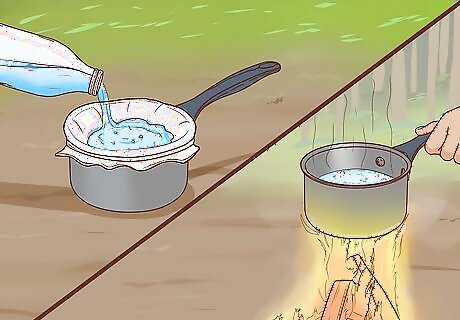
Purify any water that you find. It's extremely important that you purify any water that you collect, including rainwater, dew, and ice or snow, so you don't consume bacteria that could make you ill or even kill you. Use a piece of cloth or clothing to strain the water to remove large particles, then boil the water for 10 minutes to kill any contaminants. If you don't have a container to boil water in, you can fill a clear plastic bottle with water, seal the lid, and place the bottle on its side in direct sunlight for 6 hours to purify it. In the event that you have no containers and no way to purify water, you can dig a deep hole, let it fill with groundwater, and wait for the particles to settle at the bottom and the water is clear before you drink it. You should only do this if you have no other option.
Building a Shelter
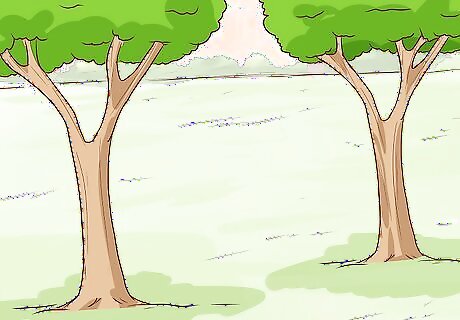
Search for a dry, flat area between 2 trees with splits in their trunks. Look around the area to find a relatively flat area with a tree that has a trunk that splits about 3–5 feet (0.91–1.52 m) off of the ground. If possible, try to find 2 trees that have a split in their trunks about 3–5 feet (0.91–1.52 m) off of the ground and are about 10 feet (3.0 m) apart from each other. If you can't find a tree with a split in its trunk, look for a strong branch or log that has a “Y” shape to serve as the support for your shelter. Clear the area between the trees of rocks and debris so it will be more comfortable to lie on.
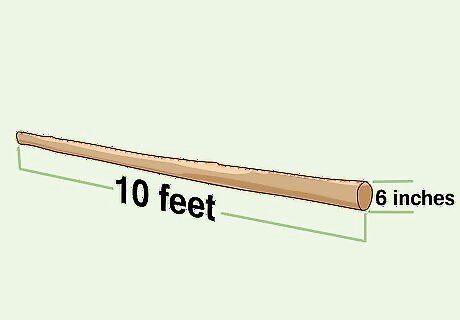
Find a branch 10 feet (3.0 m) long and 3–6 inches (7.6–15.2 cm) thick. To form your shelter you need a support beam, so look for a sturdy tree branch that isn't rotting. The straighter the branch, the better it will be for forming the structure of your shelter. Clear off any critters or spiders that may be on the branch.
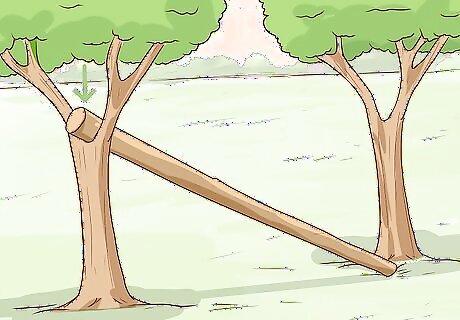
Insert 1 end of the branch into the split of 1 of the trees. Where the tree splits and forms a “V” shape, place 1 end of the branch to hold it up as a support beam. If the tree doesn't have a split, use a log that ends in a “V” shape and lean it against a tree so the branch is supported by the tree. If you have rope or twine, lash the branch to the tree to secure it even more.
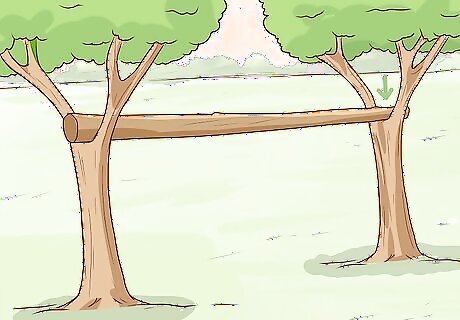
Place the other end of the branch into the split of the other tree. Form a horizontal frame with the main branch by inserting the other end in the split of a nearby tree. Make sure the branch is firmly held in place by shaking it a little.Tip: If you don't have another tree, you can rest the other end of the main branch on the ground, but your shelter will be smaller.
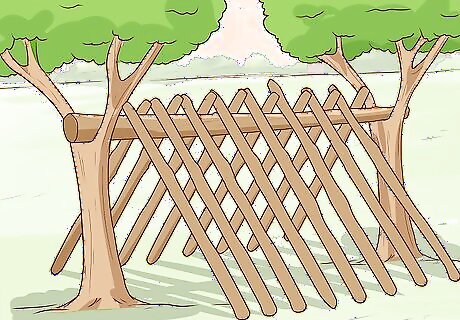
Lean branches against the main branch to form the structure of your shelter. Gather a bunch of branches that are long enough to be propped up against the main branch of your shelter. Think about forming ribs with the branches. Try to keep them as close together as you can. Try to use dry or fresh branches rather than damp or rotting ones.
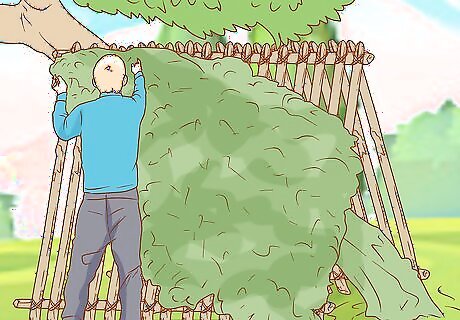
Lay twigs and leaves over the branches to form a layer of insulation. Once you've formed the structure of your shelter, use smaller, leafy branches, brush, or leaves to create a layer of insulation that will help retain heat and provide cover from the wind and rain. Lay the leaves and small branches over the frame in order of decreasing size to create a thick layer. Add layers of insulation until you can't find any holes in it and add as many layers as you can to help keep the shelter warm. If you have a tarp, drape it over the frame of your shelter.
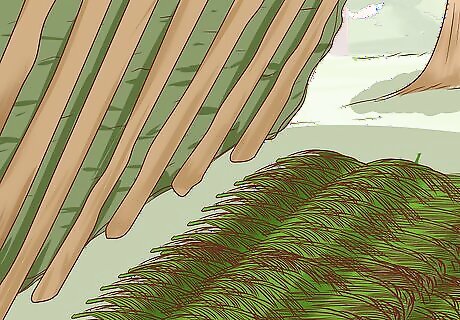
Use leaves to make a bed inside of the shelter. Try to make your shelter as comfortable as you can by finding soft material like leaves or pine needles and laying them on the ground inside of your shelter. Check for any insects or spiders on the material before you put it in your shelter.
Finding Food
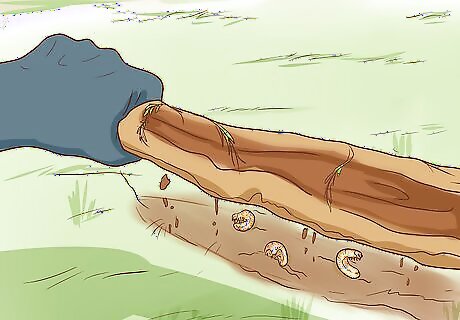
Flip over logs to search for insects that you can eat. Insects are easy to catch and kill and are packed with protein and fats that will help you survive in the woods. Check under rotting logs to look for ants, termites, beetles, and grubs. Keep an eye out for worms in the dirt, too. You can eat most insects raw, but avoid spiders, ticks, and flies. Check under stones, boards, and other materials for insects. Only eat insects that you have killed. Insects with hard outer shells like beetles and grasshoppers should be cooked for 5 minutes before you eat them to remove any parasites. Push a stick through the insect and hold it over a fire to cook it.
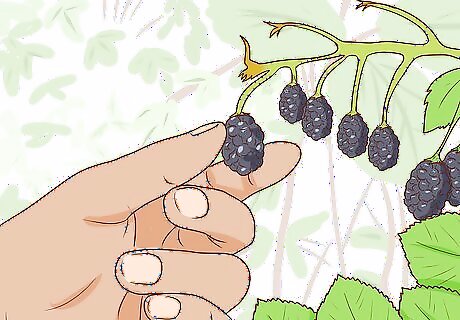
Pick wild edible berries to eat. If you happen to come by an identifiable berry bush, definitely take advantage. Never consume any berries that you cannot positively identify as many are toxic. To be safe, stick to eating berries that you recognize like blackberries, raspberries, and wild strawberries. Always avoid white berries, as most are generally toxic to humans.
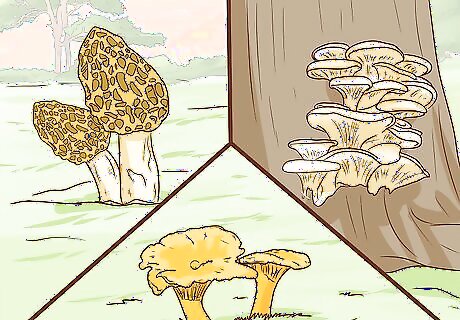
Look for edible mushrooms in the woods, if you are trained. Look for wild mushrooms near dark and damp areas or on dying trees in the woods. But be very careful because if you eat the wrong mushroom, you could become extremely ill and potentially die. If you're not sure about whether or not a mushroom is safe to eat, don't eat it! Morel mushrooms have a spongy cap that resembles a honeycomb and can be found near the bottoms of trees. Chanterelles mushrooms have a bright yellow-orange color and can be found near conifers and hardwood trees. Oyster mushrooms grow in clusters and resemble an oyster or scallop. They can be found on dying hardwood trees. Mushrooms do not offer many calories and no protein - the effort made in wandering around the woods searching for a mushroom may expend more energy than replaced by eating edible fungi. You are probably better off looking for other wild food. Unless you are trained as a mushroom expert, generally avoid collecting mushrooms. It is easy to misidentify a fungus and the risks of ingesting a dangerous substance generally outweigh the rewards.
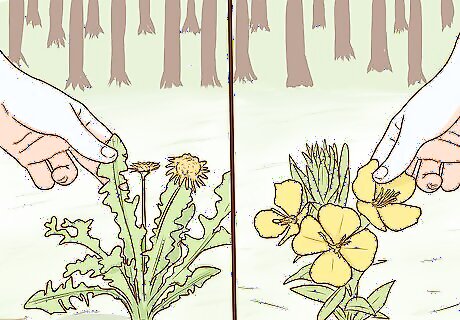
Forage for edible wild plants. There are lots of wild plants in the woods that you can eat, but you need to make sure you're gathering ones that aren't toxic. Look for dandelion leaves, the green leaves of chickweed and wood sorrel, and the tender young flowers of primrose and wild violets. If you're not sure what plant you're picking, don't eat it. Wash off any edible plants that you find.
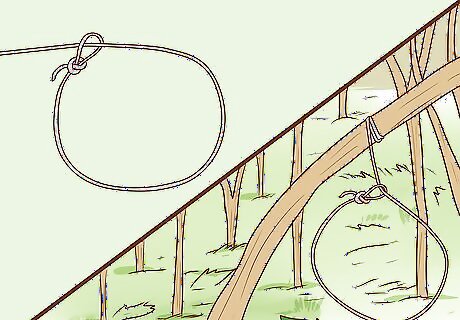
Build a snare if you have string or wire. A snare is a safe and relatively easy way to catch small game like rabbits and squirrels. Take a piece of wire or string about 2.5 feet (0.76 m) long, make a loop at one end and tie a slip knot. Then push the opposite end of the string or wire through the slip knot to form a large circle. Hang the circle of the snare over a footpath or a trail in the woods. Make a horizontal bar over the ground with a branch to hang your snare. Set up as many snares as you can in the area and check them every 24 hours to see if you've caught anything.Tip: Look for a small, beaten path that was made by an animal to place your snare.
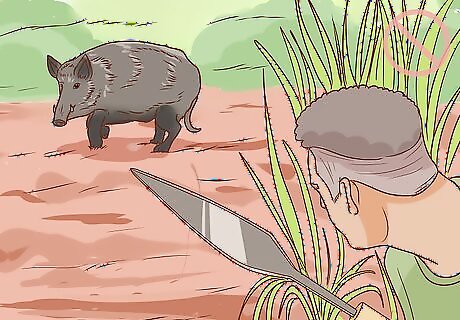
Avoid hunting large animals. If you're trying to survive in the woods, you need to be as healthy as you can be. While deer and wild pigs do have nutritious meat, they can injure you if you do not have the right gun to get the animals down humanely. Even if you can kill a deer or pig, you may not have the tools necessary to preserve the massive amount of meat that has come from the once-living animal. Small game and insects are much safer to hunt and gather and can provide you with adequate nutrition to survive in the woods. Small wounds can quickly become infected and life-threatening in a survival situation.
Starting a Fire
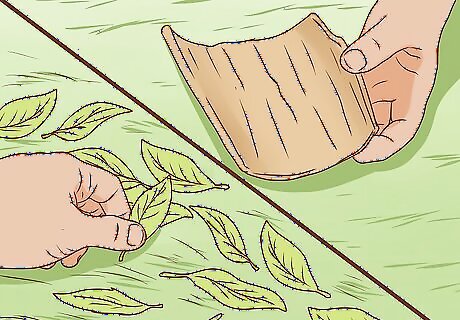
Find small, dry material to use as tinder. Look for dry grass, leaves, tree bark, pine needles, or any other small flammable materials you can find in the area. Tinder needs to be material that is easy to light and will produce a large flame so you can start your fire. If you find trash or paper in the area, that can make for great tinder as well.
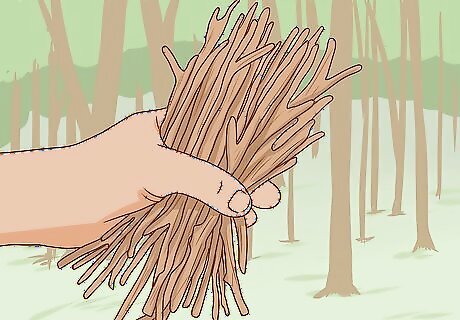
Gather small twigs and branches to use for kindling. Kindling needs to be material that will catch easily when you light your tinder. Use dry sticks, branches, or tree bark to serve as your kindling. You can break larger branches into smaller pieces to use for kindling as well.
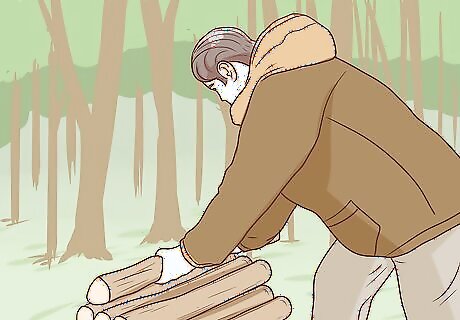
Collect larger logs for fuel. Before you start your fire, you should collect enough fuel to keep it going. Look for dry wood in the area and stack near where you plan to start your fire so you can easily add more fuel when you need it. Look for dry, brittle wood because fresh or green wood will take longer to catch. Hardwoods like oak and maple will burn for a long period of time. Dry tree stumps work great as fuel for a fire.
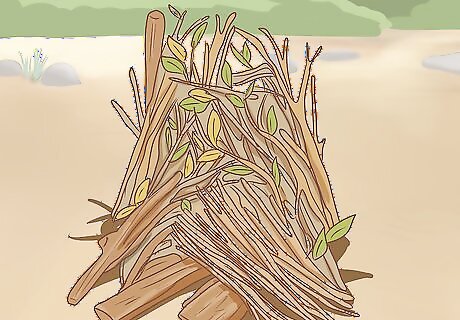
Build a teepee structure with the tinder and kindling. Clear a dry, even area of leaves, branches, or other items that could catch and spread the fire. Form a teepee structure by bunching up your tinder material and stacking the kindling together around it. Then take your larger fuel logs and lean them against each other to form a frame around the tinder and kindling. Leave a small opening so you can light the tinder.Tip: Build a fire pit around the teepee structure.
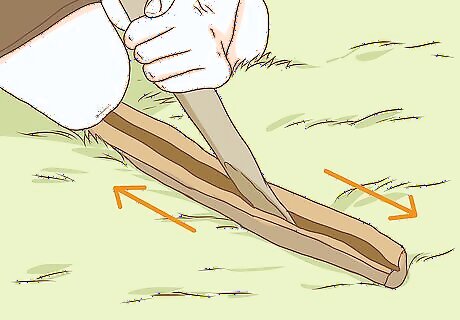
Create a fire plough to ignite the kindling and start the fire. Take a flat piece of wood and scrape a small groove into the center of it. Use another branch to plough up and down the groove to use the friction to build up heat. After a few minutes of work, the heat will ignite the wood. Act fast and light your tinder to start the rest of the fire. Use a dry piece of wood to make your fire plough. Anchor the fire plough by kneeling on it to keep it still.
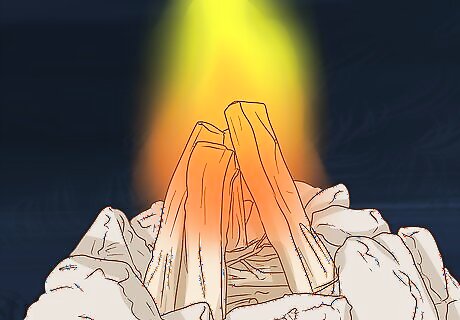
Use a fire to keep warm, cook your food, and purify your water. A fire is going to make it much easier for you to survive in the woods. Use it to keep warm so you don't get hypothermia. Cook your food on the fire and use the heat to boil water to kill any contaminants. Once you get your fire started, try to keep it from going out. When you go to sleep, place a large log on it so the coals will last until morning.
Getting out of the Woods
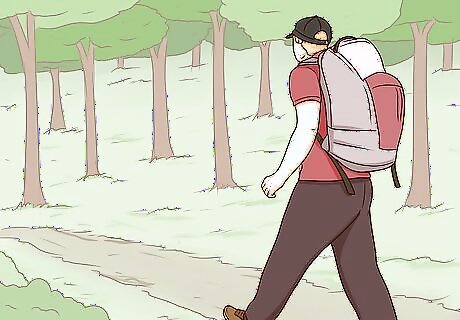
Don't panic if you get lost in the woods. Panicking can cause you to make poor decisions and affect your judgment. If you're going to get out of the woods, you need to have a clear head. Take deep breaths and focus on the tasks at hand. Focus on one task at a time to keep from getting overwhelmed. Have hope that you're going to get out of the woods.
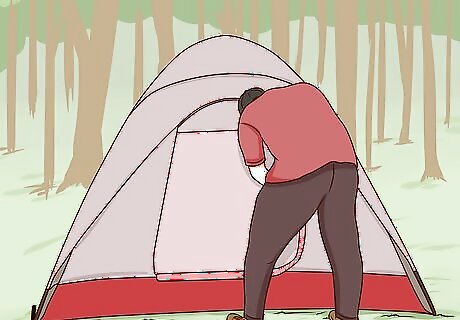
Avoid using too much energy. It may be difficult for you to find adequate food and water if you're lost in the woods. Try not to sweat or use too much energy by doing things like running around and screaming for help if you're by yourself. Conserve as much energy as you can for doing things like building shelter, fire, and searching for water.Tip: If you get lost and think that you are not too far from people, use your lungs and scream for help!

Stay where you are; do not try to find your way out. Stay put in one location for a better chance at being rescued. If you have determined you are hopelessly lost, your best tactic is to stop and hunker down in a safe place rather than to try to hike out. If you aren't safe where you are, find a safe location nearby. When lost, humans have a tendency to walk in wide circles, often coming back to the same locations time and time again. In the process, a lot of time, energy, and emotional focus is lost. If you don't know where you are, you could walk in the wrong direction and make it much more difficult for people to find you.
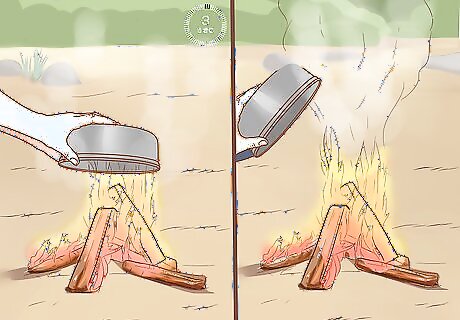
Signal your location with smoke signals. Build a fire and add a bunch of green leaves or pine needles to create a lot of smoke. Take a large branch with green leaves on it and cover the fire for 3-4 seconds to stop the smoke from escaping. Then, remove the branch to allow the smoke cloud to escape. Repeat the process to form a line of cloudy puffs of smoke in the sky. The puffs of smoke will tell people looking for you that the fire is manmade and that you're signaling your location.


















Comments
0 comment